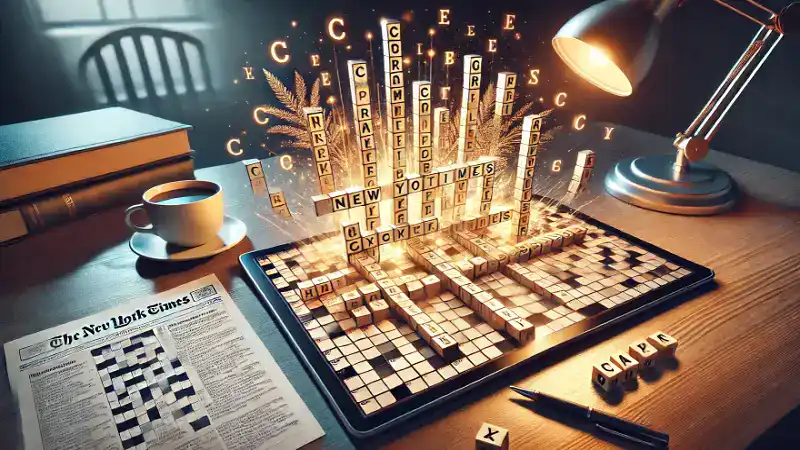Understanding the Structure of the NYT Crossword
Before diving into the hints, it’s crucial to grasp the basic structure of the New York Times crossword puzzle. The crossword typically consists of a 15×15 grid (for Monday through Saturday puzzles) or a 21×21 grid (for the Sunday puzzle). The objective is to fill the grid with words based on clues provided for each row and column.
Types of Clues You Will Encounter
The clues in the NYT crossword vary in difficulty and style. These are the most common types you will encounter:
- Straightforward Clues – These are the most common and provide direct hints. For example, a clue like “Capital of France” would have the answer “Paris.”
- Wordplay Clues – These can be tricky, often involving puns, anagrams, or homophones. A clue like “Make a loud noise?” could have the answer “Bark” (a dog’s bark).
- Cryptic Clues – These are often found in more challenging puzzles and involve complex wordplay. You may encounter clues like “Deteriorates, perhaps, ” leading to the answer “Ages.”
Daily Puzzle Difficulty
The NYT crossword starts easy on Monday and becomes more difficult as the week progresses. Monday puzzles typically feature more straightforward clues, while Friday and Saturday puzzles tend to be much trickier, requiring more advanced techniques.
Key Connections Hints for Today’s NYT Crossword
1. Start with the Easier Clues
As you begin solving the puzzle, focus on the simpler clues first. These are usually found in the first few rows and columns of the grid, especially on Mondays. Solving these straightforward clues helps you build momentum and fill in the easier sections of the grid, which will then provide hints for more challenging answers. If you’re struggling with a particular clue, move on to another one that you find easier.
2. Look for Fill-in-the-Blank Clues
In the NYT crossword, fill-in-the-blank clues often give you significant help in solving the puzzle. These clues typically provide a context or an incomplete sentence. For instance, a clue like “___ is the time to be alive” (5 letters) could lead you to the answer “Now.” These clues are often straightforward, so keep an eye out for them, especially early in the puzzle.
3. Use the Short Words to Your Advantage
Short words (especially 3- or 4-letter words) are crucial in solving the crossword. These words usually have simpler clues and are easier to fill in. By completing short words, you’ll often uncover parts of longer answers. For example, filling in the word “ART” might reveal a letter that helps you solve a more complex clue in a vertical or horizontal direction.
4. Pay Attention to Word Patterns
When solving the NYT crossword, word patterns can be your best friend. Once you have a few letters filled in, look for common prefixes or suffixes, such as “un,” “re,” “ed,” or “ing.” These can help you guess the rest of the word. For example, if you have “_ing” in a 5-letter word, you can try “bring” or “sting” depending on the clues.
5. Familiarize Yourself with Common Crossword Themes
Many NYT crossword puzzles, especially those published later in the week, have a theme that runs throughout the grid. Identifying the theme early can give you a huge advantage in solving the puzzle. For instance, a theme could involve puns, famous quotes, or related words that share a common thread. The puzzle creator often provides subtle hints to the theme within the clues, so it’s worth paying attention to recurring patterns in the answers.
6. Use Crossword Solver Tools for Tougher Puzzles
Sometimes, even the most experienced solvers will get stumped on a tough puzzle. If you’re working on a particularly challenging NYT crossword, don’t hesitate to use online tools and apps, such as crossword solvers or clue databases, to give you that extra push. These tools allow you to input the known letters and find possible word solutions. While it’s great to challenge yourself, remember that these tools are available to help you when you get truly stuck.
7. Practice Regularly to Improve Your Solving Speed
Like any skill, solving crosswords improves with practice. The more you engage with the puzzles, the quicker you’ll get at recognizing common crossword conventions, solving strategies, and word patterns. Make it a habit to solve the daily puzzle, and over time, you’ll notice your solving speed and accuracy improving.
8. Think Outside the Box with Wordplay
As you progress through the NYT crossword, particularly in the latter half of the week, you’ll encounter more complex wordplay. For example, the clue “Cents in the store?” might lead to the answer “Sense,” as the word “sense” plays on the idea of “cents.” This type of lateral thinking is essential for solving more difficult clues. Always be prepared to think creatively, especially when the clue seems like it could have multiple interpretations.
Leveraging Online Communities for Help
If you’re struggling with a particularly tricky NYT crossword, it can be helpful to connect with others who enjoy solving puzzles. There are many online communities, such as the NYT crossword forum or Reddit’s crossword subreddit, where solvers share tips, discuss clues, and offer help with difficult puzzles. Joining these communities can help you learn new solving techniques, get hints when you’re stuck, and engage with other passionate crossword enthusiasts.
Develop a Routine: Solving with Consistency
To truly get better at the NYT crossword, it’s important to establish a consistent solving routine. Make it a part of your daily routine, perhaps during breakfast or as a break during your workday. Solving puzzles consistently will help you build your puzzle-solving muscle, and over time, you’ll start to recognize patterns more easily, making the problem-solving process quicker and more enjoyable.
Final Thoughts: Embrace the Challenge
The NYT crossword puzzle is an excellent way to sharpen your mind, challenge yourself, and have fun. By employing practical strategies like focusing on short words, spotting patterns, utilizing crossword solver tools, and practicing regularly, you’ll gradually improve your skills and become a crossword master. Don’t get discouraged if you encounter difficult puzzles—every puzzle is an opportunity to learn and grow. Keep solving, and remember that each completed puzzle is a victory in itself.
Happy puzzling, and enjoy solving today’s NYT crossword!
Key Takeaways:
- Focus on the easier clues first to gain momentum.
- Use fill-in-the-blank clues as they are often straightforward.
- Short words are your best friends in the early stages of solving.
- Look for word patterns and crossword themes to guide your solving.
- Use crossword solver tools when needed, but don’t rely on them excessively.
- Join crossword-solving communities to learn and share tips with others.
By following these steps and honing your puzzle-solving techniques, you can confidently approach the NYT crossword each day, mastering each puzzle one clue at a time.
Learn more Connections Hints


